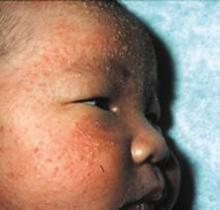MIAMI BEACH – Acne presentation, treatment, and counseling will vary according to whether your patient is a neonate, infant, child, preadolescent, or teenager, according to Dr. Jonette E. Keri.
• Neonatal acne. These small, erythematous papules that arise before 6 weeks of life probably represent a heterogenous set of conditions. Ketoconazole cream 2% twice per day is a treatment option.
However, "a lot of doctors choose not to treat because it’s not a scarring process," Dr. Keri said. You can reassure parents that most neonatal acne improves relatively quickly, usually within a few months. If true comedones are present, consider treatment with the same acne mediations indicated for infantile acne.
• Infantile acne. Infantile acne appears in children up to 1 year, usually at 3-6 months of age. Male infants are more prone to acne than female infants, and lesions tend to appear on the cheeks and chin and have the appearance of classic adolescent acne. Increased sebum production and some comedones are often present.
"You should treat because it can cause scarring," Dr. Keri said. Also, "this acne may predispose [children] to worse acne in teenage years – that is shown to be true for any form of infantile acne. It doesn’t have to be severe," said Dr. Keri of the University of Miami and chief of dermatology services at the Miami VA Hospital.
She offered the following clinical tips for treating and managing acne based on developmental age:
Combine treatments and use products appropriate for a baby, Dr. Keri advised at the South Beach Symposium. Although some experts recommend benzoyl peroxide, proceed with caution. The concern is getting any benzoyl peroxide near a baby’s eyes, "so you probably want to stay away from the washes."
Treatment options include topical antibiotics, adapalene, or a retinoid like tretinoin. Oral erythromycin is another acceptable option, she said.
"Isotretinoin is actually indicated if a severe, scarring process is going on," said Dr. Keri. She said that she searched the literature and found that some clinicians prescribe isotretinoin in children as young as 5 months.
• Midchildhood acne. "It is a newer concept, but a very important concept," Dr. Keri said. Acne is relatively rare between the ages of 1 and 8 years. During this time androgens in the body should be low and stable.
If acne does arise, it could point to an underlying hormonal abnormality. Evaluate three things: bone age, the growth chart, and hormone levels. "That may be a bit much for a dermatologist, but a pediatrician does these evaluations often," she said.
Accelerated bone age on a wrist radiograph can point to androgen excess, whereas delayed bone age suggests Cushing’s disease. A growth chart that shows a child’s height crossing percentiles upward or increasing faster than would be expected can also suggest androgen excess.
"Hormone levels can be tricky," Dr. Keri said. High levels of androgens, free testosterone, or dehydroepiandrosterone also can occur with tumors or polycystic ovarian syndrome (PCOS). "Another reason they can be tricky is because the child is developing into an adult, so you may need a pediatric endocrinologist to tease this out."
• Preadolescent acne. Treatments for children aged 9-12 years are essentially the same as for infants and midchildhood patients. However, patient counseling plays a bigger role. "Adherence is a big issue with these kids, so try to give them a once-a-day regimen," Dr. Keri said. Isotretinoin is rarely prescribed in this age group, but if severity dictates the need, it is likely the child will need retreatment (two or three courses) over time.
Comedones, seborrhea, and even PCOS are associated with preteen acne. Rule out precocious puberty and distinguish abnormal hormonal changes from normal signs of puberty, Dr. Keri recommended.
"PCOS is very complicated; you are going to need some help, a multispecialty approach," Dr. Keri said. Early diagnosis is worthwhile, she added. "If you identify PCOS when these young ladies are younger, you can prevent infertility, diabetes, [and] coronary artery disease, because they get these things more often than a woman who doesn’t have PCOS."
• Adolescent acne. Speaking directly and appropriately with teenagers about their acne can facilitate better outcomes, Dr. Keri said. For example, instead of asking, "How many days a week do you use your medicines?" ask, "How do you use your acne medicines?" Also determine their expectations before prescribing, and find out if they have a prom or other major social event coming up.


